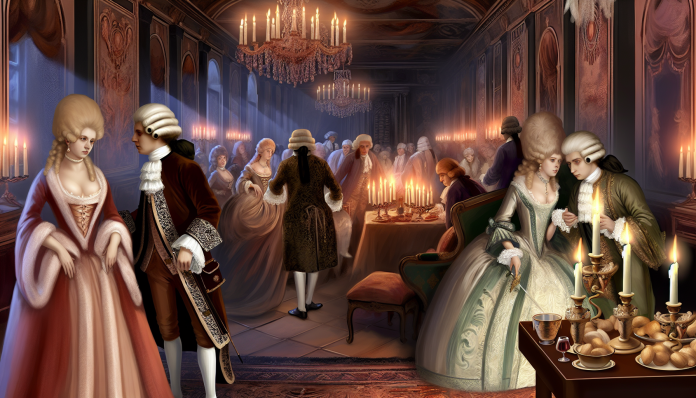Introduction
In the opulent halls of Versailles, where art merged seamlessly with the politics of one of history’s most powerful monarchs, the legendary King Louis XIV, the “Sun King,” ruled not just by divine right but also by sensual indulgence. The 17th century was a time characterized by strict societal norms surrounding sex and relationships, yet Louis XIV deftly navigated and often subverted these expectations. The King’s bedchamber was a canvas on which he painted his desires, creating a scandalous portrait of hidden mistresses and extravagant orgies that would lay the groundwork for contemporary discussions about power, sexuality, and morality.
As we peel back the layers of the past, we uncover a world far removed from today’s liberal values. This article will delve into the hidden mistresses of Louis XIV, exploring not only the scandal itself but also its ripples through society and how these permissible acts of debauchery contrast sharply with today’s social standards.
The Scandal
King Louis XIV ruled France from 1643 to 1715, a period marked by lavish excess and absolute power. Central to his reign was the idea of Versailles as a symbol of his authority. Amid the captivating beauty of the palace, however, the King’s private life spun a tale of intrigue, desire, and countless liaisons.
Notable Mistresses
Among his numerous paramours, Madame de Montespan remains the most infamous. Entering the King’s court around 1667, she quickly captured Louis XIV’s attention, outshining his prior mistress, Louise de La Vallière. Montespan held significant influence over the King, aside from her well-documented amorous escapades. It was whispered that she even summoned magic to secure his affection. Additionally, Louise de La Vallière, with her early role in Louis’s life, became a symbol of his initial romantic pursuits before being overshadowed by Montespan’s flair.
These relationships were not merely personal; they were intricately tied to the politics of the court. Engaging in affairs of the heart allowed mistresses to wield influence over appointments and state matters, committing power plays that would hold serious consequences for the political landscape of France.
Orgies and Extravagance
While Montespan may have shaped Louis’s desires, it was within the private parties and extravagant orgies that his reign was truly characterized. These events were often shrouded in extravagance, involving not just food and drink but also music, disguises, and hidden identities, which fed the otherworldly allure of court life. Accounts from the time suggest that such exhibitions were not simply acts of pleasure; they were forms of political manoeuvring, with various nobles attempting to curry favor with the King through indulgence in these decadent festivities.
Contemporary diaries, such as those penned by court observers like Saint-Simon and La Rochefoucauld, hint at the scandalous nature of these gatherings. While they remain entwined in euphemism and innuendo, the core narrative portrays a sovereign unbound by the constraints of his own laws, reveling in more than just the pleasures of the flesh.
Moral and Cultural Analysis
Society’s Reaction
In the conservative context of the 17th century, Louis XIV’s exploitation of his power to pursue sexual voracity ignited societal debates. On one hand, the court revered him as a god-like figure, essentially above moral reproach; on the other, whispers of scandal spread among the populace. While the average citizen experienced severe restrictions on personal and sexual freedoms, the King’s capricious behavior drew a stark line between the aristocracy’s indulgences and the commoner’s modest existence.
However, while many held their breath and gossiped about the King’s antics, historical sources suggest that the public largely tolerated, if not tacitly accepted, his behaviors as part of his grandiosity. The façade of a devout monarch outweighed the implications of his rampant personal life, and the culture of the court lent itself to an environment where moral boundaries were frequently tested.
Contemporary Perspectives
Fast forward to the present day, and we observe how such extravagant indulgences would be scrutinized under a different moral lens. A modern audience, steeped in values of consent, equality, and feminism, would regard the sexual politics of King Louis XIV with a critical eye. The idea of a monarch hosting orgies or engaging with multiple partners without regard for platonic love or respect would be viewed as problematic at best and exploitative at worst.
The societal perception today champions the importance of ethical boundaries in relationships, contrasting sharply with the unregulated fantasies of the past. The modern discussion extends beyond personal choice to encapsulate issues of power dynamics, suggesting that those with authority carry the responsibility to engage ethically.
Conclusion
The hidden mistresses of King Louis XIV and his penchant for hedonistic escapades tell us more than mere tales of royal scandal; they unearth a complex history of power, sex, and societal expectation. As we reflect on Louis’s reign, it’s evident that shifting attitudes toward sexuality and morality serve as a mirror to our current values.
While Louis XIV basked in the glory of unchecked desire, contemporary society encourages a much more nuanced understanding of relationships and their implications. It is a testament to how dramatically perceptions have shifted over the centuries—from the acceptance of debauchery among the elites to a critical examination of privilege and personal freedom today.
Engaging with these historical contexts allows us to question and redefine our own values, nudging us to think critically about how the past informs our present. In the end, the chronicles of sex—whether captured in the ornate halls of Versailles or through the bold expressions of modern relationships—remain a pivotal part of human history, revealing timeless truths about power, pleasure, and humanity itself.

